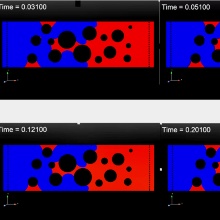New SFB 1313 publication, in collaboration with Procter and Gamble, published in Advances in Water Resources:
Authors
- Santosh Konangi
- Nikhil K. Palakurthi
- Nikolaos K. Karadimitriou (SFB 1313 research projects B05 and C05)
- Ken Comer
- Urmila Ghia
Abstract
Conventional macroscale two-phase flow equations for porous media (such as Darcy's law and Richards Equation) require a constitutive relation for capillary pressure (Pc). The capillary pressure relation significantly impacts the behavior and prediction of fluid flow in porous media, and needs to accurately characterize the capillary forces. In a typical laboratory experiment, a functional macroscopic capillary pressure-saturation (Pc-Sw) relationship is measured as the difference between the pressures of the non-wetting-phase reservoir at the inlet (Pnw) and wetting-phase reservoir at the outlet (Pw) of a porous medium. It is well-known that this traditional macroscopic capillary pressure definition is valid only at equilibrium conditions and if the phases are connected. Under non-equilibrium (dynamic) conditions, when the fluids are moving, the macroscopic capillary pressure measured in experiments implicitly includes the pressure head caused by viscous effects.
The goal of the present effort is to understand how well the traditional macroscopic capillary pressure definition represents the pore-scale capillary forces under different flow conditions. Using direct numerical simulations (DNS) of two-phase flow in a porous medium, we evaluate the capillary pressure at the pore-scale, and compare it to the macroscopic capillary pressure, Pc(Sw), that is typically measured in experiments using pressure transducers. The pore-scale capillary pressure is the pressure difference across the interface between two fluids as the fluids move through a porous medium; the interface pressure differences at fluid-fluid invasion front are averaged across all the pores of the porous medium to yield a representative pore-scale capillary pressure curve, referred to as the interface capillary pressure. The pore-scale interface capillary pressure represents the “true” capillary forces in the system, since depends only on the pore morphology (shape) and interfacial energy of the two fluids, and does not account for the viscous dissipation. In experiments it is difficult to measure the interface capillary pressure jump without accounting for the viscous pressure head, which is at least an order of magnitude larger. Upscaling the pore-scale capillary pressure is an essential step for complete characterization of capillary-dominant two-phase flow in a porous medium at the laboratory scale.
Drainage is simulated under equilibrium (quasi-static) and non-equilibrium (dynamic) conditions for various capillary numbers. The Navier–Stokes (NS) equations are solved in the pore space using the open-source finite-volume computational fluid dynamics (CFD) code, OpenFOAM. The Volume-of-Fluid (VOF) method is employed to track the evolution of the fluid–fluid interfaces, and a contact angle is used to account for the effect of wall adhesion. The simulations are first validated with published experimental data for dynamic and quasi-static drainage in a micromodel. From the microscale simulations, the interface capillary pressure is determined, and compared to the macroscopic capillary pressure under equilibrium and non-equilibrium conditions. Our results show the traditionally-measured macroscopic capillary pressure curves exhibit a strong dependence on the capillary number under dynamic flow conditions. In contrast, the interface capillary pressure-saturation relation, which relies on pore-scale pressure differences at the invasion front, is almost invariant of flow conditions (dynamic and quasi-static).
Contact

Nikolaos K. Karadimitriou
Dr.Principal Investigator, Project Z02 (PML)
[Photo: Max Kovalenko]


